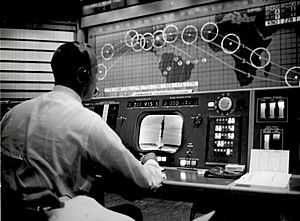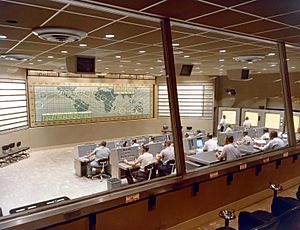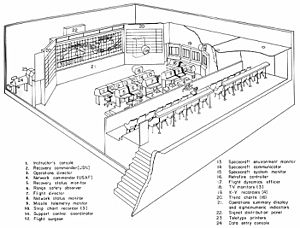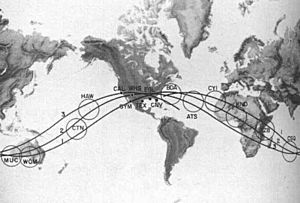Mercury Control Center facts for kids

The Mercury Control Center (also called MCC) was like the brain of early American space missions. It was a special room where NASA engineers and flight controllers managed the first spaceflights, including those from Project Mercury and the very first Project Gemini mission, Gemini 3. This important building was located at the Cape Canaveral Space Force Station in Florida, close to where rockets launched.
The MCC was expanded in 1963 to help with Project Gemini missions. This meant adding more rooms for meetings, analyzing data, and even a large area for training astronauts with a Gemini spacecraft simulator.
As space missions became more complex, especially with later Gemini flights and the Apollo missions to the Moon, a bigger control center was needed. So, the main control operations moved to a much larger facility in Houston, Texas. However, the Mercury Control Center still played a role. It was used for training new flight controllers and for important meetings. From 1967 until the mid-1990s, it was even a popular stop for public tours, letting people see where space history was made!
How the Control Center Was Set Up
The Mercury Control Center was smaller and simpler than the mission control centers we see today. It had three rows of consoles where different teams worked. This setup was perfect for the early Mercury missions, which usually lasted no more than 36 hours. The spacecraft themselves were also less complicated back then.
Each position in the MCC had a specific job. Some teams monitored the spacecraft and astronauts during flight. Others focused on supporting the rocket launch or helping with the capsule's return to Earth.
A cool feature of the MCC was a huge map that lit up from behind. It showed where the space capsule was in orbit. Unlike today's computer screens, this map used a physical model of the capsule. This model was moved and lit up in front of the map to show its exact position in space.
Later mission control centers were often split into two main parts. One part, called launch control, stayed at the launch site like Cape Canaveral. The other part, mission control, was located far away, like at the Lyndon B. Johnson Space Center in Houston for Apollo and Space Shuttle missions. For robotic missions, control centers like the Jet Propulsion Laboratory are used.
Tracking Stations Around the World
Even though the Mercury Control Center managed the missions, it wasn't the only place involved. A huge network of tracking stations and communication centers around the world helped keep in touch with the spacecraft. The Computing and Communications Center, located at the Goddard Space Flight Center in Maryland, provided the powerful computers needed for the missions.
To make sure the spacecraft was almost always in contact with the ground, many extra ground stations were set up. These stations were at U.S. military bases, on special tracking ships, and in cooperation with countries like Spain, the United Kingdom, Nigeria, and Australia. Here are some of the key locations:
- Cape Canaveral (CNV-MCC)
- Grand Bahama Island (GBI)
- Grand Turk Island (GTI)
- Bermuda (BDA)
- Atlantic Ship (ATS)
- Maspalomas Station, Grand Canary Island (CYI)
- Kano, Nigeria (KNO)
- Zanzibar (ZZB)
- Indian Ocean Ship (IOS)
- Muchea, Australia (MUC)
- Woomera, Australia (WOM)
- Canton Island, Kiribati (CTN)
- Kauai, Hawaii (HAW)
- Point Arguello California (CAL)
- Guaymas, Mexico (GYM)
- White Sands, New Mexico (WHS)
- Corpus Christi, Texas (TEX)
- Eglin Air Force Base (EGL)
Where the Building Was Located
The Mercury Control Center building was built between 1956 and 1958. It was used throughout Project Mercury (1961–1963) and for Project Gemini until the Gemini 3 mission (1964–1965).
In 1999, many of the original consoles and equipment from the Flight Control Area were moved. They became part of an exhibit at the Kennedy Space Center Visitor Complex. You can still see them on display today in the complex's Dr. Kurt H. Debus Conference Facility.
The original building itself was listed as a historic place in 1984. However, it would have cost about $6 million to remove asbestos, make repairs, and restore it. So, the decision was made to save the important equipment and tear down the building.
Today, the consoles and displays are carefully put back together at the Kennedy Space Center Visitor Complex. They create a recreation of the Mercury Control Center, and many of them are even powered on, giving visitors a real feel for what it was like during those exciting early days of space exploration.
Images for kids
-
Recreated MCC Flight Control room on exhibit at the Kennedy Space Center Visitors Complex
-
John Glenn in front of Mercury Control









